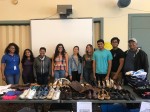Freddie McGregor and The Big Ship Band, Rayana Jay, Etana, and more jammed out at the Sunset Canyon Recreation Center on Monday.
Metro will partially cover Westwood businesses’ revenue losses during construction
Los Angeles Metro will offer local businesses compensation for lost revenue during construction of the Purple Line Extension into Westwood.
Metro authorized the expansion of the Business Interruption Fund, which provides funds to locally owned small businesses impacted by transit construction, to compensate businesses for revenue lost during construction of the third and final section of the Purple Line Extension. The extension project will bring two new stations to the corner of Wilshire Boulevard and Westwood Avenue and the Veterans Affairs West Los Angeles Medical Center.
The BIF will distribute $10 million annually. Businesses may receive a maximum of $50,000 in BIF assistance per year. The funds generally go toward operating expenses like utilities, rent, payroll and insurance, according to Metro’s website.
The BIF is already aiding businesses affected by construction of sections 1 and 2 of the Purple Line Extension. The first section will extend the current Purple Line from Koreatown through Miracle Mile. The second section of the Purple Line Extension will continue the Purple Line from Miracle Mile through Beverly Hills and into Century City.
Factors like the location of the business, the type of business and demonstration of revenue loss during the time of construction all affect how much and if businesses receive BIF funds, said Paula Carvajal, the Metro BIF program manager.
Location is the most important eligibility requirement, Carvajal said. A business must be located along Wilshire Boulevard to be eligible for the BIF.
A business must employ fewer than 25 full-time workers to qualify. Metro’s goal is to help these businesses thrive throughout and after construction of the Purple Line Extension, according to Metro’s website.
Construction for the Westwood extension will start in 2020, and Metro is currently reaching out to businesses in the area, Carvajal said.
[Related: Metro Purple Line Extension construction to increase Westwood traffic]
Ilya Ivanov, a UCLA Extension student, said he works at the Hammer Museum and there is noticeable construction nearby. He added that although he can sometimes hear the construction while working, it has not affected the museum or its business in any major way.
However, Ivanov said construction may affect private business owners differently.
Andrew Thomas, executive director of the Westwood Village Improvement Association, said he thinks it is important to help Westwood Village businesses during construction.
“These businesses really add so much character and uniqueness to our district that it’s very important that we give them all the help they need during what we know is going to be a very difficult time,” Thomas said.
Thomas added the WVIA has become increasingly concerned about how construction may limit people’s access to the Village.
“There’s not a lot of ways to get to (the Village), so it’s important that everybody be creative and open to solutions that will help us survive the construction,” Thomas said.
Sithara Menon, a second-year biology student, said although Purple Line construction may be inconvenient in the short term, the long-term benefits will outweigh the costs.
“It’s a small price to pay to have a little bit of construction now to actually have a good transit system in the future,” Menon said. “We need sustainable and affordable transportation systems, and it seems that everyone around here is forced to depend on their cars.”
Thomas said the WVIA invited Metro to the association’s July meeting to further discuss upcoming construction and additional efforts to help people access Westwood Village, such as maps, signage and other forms of public transportation.
UCLA community offers views on possibilities, shortcomings of SAT ‘adversity score’
UCLA professors and students said they do not think a new score that aims to provide context on the challenges students face will be immediately effective in increasing disadvantaged students’ access to higher education.
The College Board, a nonprofit organization that administers the SAT, announced May 17 it will implement the Environmental Context Dashboard, which has been referred to as an “adversity score” by other media outlets. The ECD generates a score, based on College Board data and national data from the United States Census and the National Center for Education Statistics, to provide context on students’ socio-economic and academic backgrounds as a supplement to SAT scores.
The ECD aims to provide admissions applications readers with information on students’ communities and high schools, including family income, crime rate and opportunities for Advanced Placement classes, said College Board CEO David Coleman, in an email statement.
The ECD will not change the score the student receives on the SAT, Coleman said. He added the College Board has pilot tested the ECD at 50 colleges and universities, not including UCLA, and plans to expand it to more schools in 2020.
“The Environmental Context Dashboard shines a light on students who have demonstrated remarkable resourcefulness to overcome challenges and achieve more with less,” Coleman said. “It enables colleges to witness the strength of students in a huge swath of America who would otherwise be overlooked.”
Reports from schools that have pilot tested the ECD suggest the dashboard allows college admissions readers to recognize applicants who were highly disadvantaged, Coleman said.
“Providing additional contextual information about a student’s SAT score was found to more positively influence admissions decisions when readers were less familiar with the high school, and for students whose academic performance exceeded that of their peers by the widest margins,” Coleman said.
UCLA professors said while the ECD recognizes the nonacademic factors that influence a student, it is still in need of change.
Ozan Jaquette, an assistant professor in higher education at UCLA who was consulted on the creation of the ECD, said the dashboard is a reflection of decades of social science research. He said research on decision-making bias suggests admissions readers might credit a disadvantaged applicant’s lack of achievements to a lack of ability or effort when they know little about an applicant’s background.
“If you provide contextual information, then they attribute someone not taking a bunch of AP classes not due to their own personal lack of effort, but rather more to the educational context,” Jaquette said.
Tyrone Howard, an education professor at UCLA, said he thinks colleges have to improve their methods of assessing students, and that while the ECD is an improvement, it does not go far enough. Howard said his main concern is that the ECD does not consider the effects of race on a student’s education and background.
“Poverty matters and historical discrimination matters, and racism and sexism matters,” Howard said. “And I think for us to not think about those factors is a bit irresponsible.”
Howard said he thinks the SAT has historically failed to welcome a diverse population of students, and was designed to enforce racial superiority. He said colleges should come up with more creative ways of assessing students that better reflect their academic performance throughout high school.
“Students spend four years in high school,” Howard said. “That’s four years of data as opposed to one data point from one test that students sit down to take.”
He added he thinks the issue of transparency in college admissions is important, especially following the college admissions scandal, in which parents bribed elite colleges to gain admission for their children. He said he is concerned parents might manufacture adversity to increase their child’s adversity score and make their child’s case seem more compelling.
“We need to think hard, we need to be honest about who has advantages and who still does not have opportunities,” Howard said.
UCLA spokesperson Katherine Alvarado said in an email statement the university considers the context of students’ educational opportunities and personal lives when evaluating their applications.
“The curriculum and counseling available in one school setting might vary significantly from school to school and we seek to ensure that we are evaluating that student in the context of opportunities available to them,” Alvarado said.
Alvarado added UCLA Undergraduate Admission will consider taking the ECD into account, and how that information might impact the way admissions readers review applications.
Students had mixed responses about whether the ECD could help students from low-income backgrounds.
Nayelly Sanchez, a second-year neuroscience student, said she thinks the ECD will help to diversify student populations, and help students from low-income backgrounds.
“For the admissions officers, getting to see the whole picture instead of just one part of it gives a better chance of (low-income students) getting accepted,” Sanchez said.
Naomi Riley, a second-year political science student and the Academic Affairs commissioner for the Undergraduate Students Association Council, said she has advocated for dismantling the SAT and ACT admissions requirement and she does not endorse the ECD because she does not think it will help disadvantaged people in the ways it has been proposed to.
“We’ve seen that people with money and people who have the means to will do almost anything to get their kids into … schools,” Riley said. “Just as easy as it is for people with money to pay for tutors, I feel like it’s just as easy to go around a lot of these barriers to (increase) their adversity score.”
Riley added she thinks colleges should come up with more creative ways of assessing a student’s merit and their potential to succeed, and the ECD does not account for individual factors that affect students’ achievements.
“I think the push towards the adversity score is kind of like standardizing and categorizing struggle, which I think is problematic in itself,” Riley said. “And I think it really generalizes people’s personal history and struggle and things of that nature.”
Jaquette said he thinks the effects of the ECD will be marginal because universities may still admit students based on how much they can contribute in tuition. He said even if universities admit the majority of low-income students one year, they may compensate for the loss in tuition revenue by admitting students from higher-income backgrounds the next year.
However, he said he thinks the ECD may become more effective once it undergoes further adjustments.
“It’s a way to focus on the merit of the applicant in light of the opportunities that were available to them, and ideally that’s what the Environmental Context Dashboard captures,” Jaquette said. “I don’t think it’s doing that quite yet, but I think that’s the idea, and that idea is a good one.”
Study says aquaculture may be viable source of food, if done in the right areas
Ocean farming may provide a solution for global hunger and climate change, UCLA researchers found.
A yearlong study published in the journal Marine Policy by researchers with the Institute of the Environment and Sustainability at UCLA found ocean farming could alleviate a large portion of global hunger, promote biological diversity and minimize the impact of carbon emissions from land farming.
Aquaculture, or ocean farming, is the cultivation of marine life for human consumption under controlled conditions.
Ian Davies, the paper’s lead researcher and a graduate student at the University of Washington, said increasing the global rate of ocean farming could sustain world fish demand and lead to the aforementioned benefits.
The study analyzed data from 144 countries. Researchers looked at each country’s gross domestic product, current regulations in place and gross potential index, said Davies, who received his bachelor’s degree in environmental science from UCLA in 2015.
GDP was used as a measure of financial feasibility, while the country’s current laws were assessed to determine the government’s ability to mediate environmental damage. GPI collects information on oxygen levels and temperature, which was used to measure how environmental conditions promote fish growth.
Following analysis of these factors, researchers placed the countries into three groups: ideal “goldilocks” producers, at-risk producers and nonoptimized producers.
Sixty-seven countries, including Nigeria, China and India were deemed “goldilocks” producers, Davies said. These nations have the proper biological, legislative and fiscal conditions for raising and harvesting fish.
Twenty-four countries, such as Norway and those bordering the Persian Gulf, were identified as nonoptimized. These countries have waters that lack the proper GPI for fish farming. Additionally, these countries may not have appropriate regulations regarding aquafarming.
The final 77 countries were classified as at-risk producers. At-risk producers do not have the necessary conditions and are harming the environment with their current level of fish production, Davies said.
Peter Kareiva, a researcher and director of the institute, said government regulation is vital to the protection of marine ecosystems.
Davies said he agrees that regulation is essential, but that overregulation can be a problem as well, noting that Ireland’s previous fish harvesting licensing process discouraged potential farmers because it was time-intensive.
Sarah Bryson, a marine community ecologist and UCLA alumna, said she thinks regulation is necessary in some areas of ocean farming, as legislators must find ways to ensure harvesters do not disturb ecosystems when removing fish from their habitats to place in captivity.
“I know we often worry about overfishing, but it’s also necessary to understand how any sort of modification of existing ecosystems affects the niches organisms have made for themselves,” Bryson said.
Davies said the novelty of ocean farming makes it unclear what the risks and opportunities of the practice are.
“It’s a relatively new technology, growing fish out in the ocean, and we’ve seen a lot of the harm from traditional agriculture on land,” Davies said. “We are very serious about where aquaculture is happening … and how things can be done in a sustainable way.”
Bruins for Accessible Resources holds first fair, providing variety of goods
Jayesh Menon became motivated to fight homelessness after witnessing a homeless woman begging for food with her infant daughter in Westwood Village last summer.
“Everyone around us (was) ignoring her,” he said. “And that just really struck me, and that’s why I decided, you know, I should do something about this.”
This led Menon, a third-year microbiology, immunology and molecular genetics student, to create Bruins for Accessible Resources, which coordinates the efforts of different homelessness outreach groups on and off campus to provide physical and mental health resources for homeless individuals in Westwood.
The organization, which was founded fall quarter, held its first resource fair Saturday using donations from Good Clothes Good People, the Westside Food Bank and several other charitable organizations. It offered resources ranging from clothes, shoes and hygiene products to umbrellas and tubes of chapstick.
Menon said although only a few people attended the fair, it was a good trial run.
“Since we’re just getting started, I think our next steps would be using this as a learning experience and figuring out how to improve,” he said.
The homeless population in Westwood is growing, said Mark Jones, Sr., the director of mission and outreach at the Westwood Presbyterian Church. Jones is also a board member of People Assisting the Homeless, a networking organization which also works to coordinate homelessness advocacy organizations with different focuses.
Homelessness in LA has increased even though the city has built tens of thousands of new homes over the past 30 years and support and advocacy for homeless individuals has increased, Jones said.
Menon said he and other UCLA students decided the best way to address the problem of homelessness in Westwood was to reach out to UCLA-affiliated and unaffiliated groups to coordinate their efforts.
“We realized that we shouldn’t try to reinvent the wheel, we should just collaborate with all these organizations and bring them to Westwood,” he said.
Sneha Thirkannad, president of GCGP and a second-year political science and study of religion student, said Bruins for Accessible Resources allows other groups to support homeless individuals in different aspects and consolidate their efforts.
“The (Westside Food Bank), you know, they focus mostly on food and we focus mostly on the clothes, and then another organization might do more hygiene products,” she said. “So bringing all of us together means that we can contribute each thing, but all things together, … that’s all of the different basic needs somebody may have.”
[Related: Student-run basic needs redistribution center to open in activities center]
Thirkannad said GCGP hopes to continue collaborating with Bruins for Accessible Resources to put on more resource fairs in the future.
Jones said events such as the Bruins for Accessible Resources’ fair provide hope both to individuals affected by homelessness and those who want to help them.
“This event, and events like it, put a highlight on the need, and the desire to meet the need, on both sides of the equation,” he said.
Alumnus discusses role in Asian cast production of ‘Mamma Mia!’
BY OLIVIA MAZZUCATO
Daily Bruin reporter
UCLA alumnus Andrew Ge had acted for film and television, but he had never been in a musical when he attended the open call auditions for “Mamma Mia!”
However, Ge had a background in live performance while at UCLA – he had been a part of the marching band, Samahang Modern dance crew and the UCLA Chorale and Chamber Singers. Ge was cast in the ensemble of East West Players’ production of the ABBA musical, starring a predominantly Asian cast, which runs at the David Henry Hwang Theater until June 16.
Ge discussed his role, the atmosphere of the production and the show’s larger cultural context with the Daily Bruin’s Olivia Mazzucato.
Daily Bruin: Being in the ensemble means something different for every musical. What does it mean in particular for “Mamma Mia!” and what do you do?
Andrew Ge: (This cast) is technically the largest cast for East West … but I think in the grand scheme of “Mamma Mia!” productions, it’s actually relatively small. We have the major dance productions that we’re all in and then when we’re not on stage singing … we’re singing in all the songs’ background. … It kind of almost just feels like we’re people living in this city, in this town, and we’re just kind of going about our daily routine of just moving stuff around.
DB: How does this compare to other productions that you’ve worked on?
AG: Definitely having an all-Asian POC cast … that is just something on its own. Even working on TV and film stuff, commercial stuff, it’s rare to be in that sort of environment and I think the sort of camaraderie and family that we built within this production is something that I have never experienced before.
DB: “Mamma Mia!” isn’t a musical or story defined by race, but it’s often cast predominantly white. What was the impact of having Asian American performers in a show that historically hasn’t been inclusive and in a story that doesn’t necessarily center identity?
AG: A lot of the times you’ll read a story … and we automatically default to Caucasian … that’s just something that’s been rooted in our heads for so long … I think because of the history of entertainment and the media, especially Asians, we have always seen ourselves in the background, we’ve never really seen ourselves portrayed in these stories. So it was really amazing to look at this story up close and be like, “Wait, there’s nothing really that makes this family have to be a white family.”
A lot of the story elements (were) very similar to Filipino culture and this makes sense how this family would act in this way. I think it was just amazing how well everything just translated, how well we could all relate to just being a family and not having to view it by racial standards.
DB: Do you have any favorite moments from rehearsal or the show?
AG: This was maybe like a couple weeks into rehearsal, but we all got dinner at Park’s Finest – it’s a Filipino restaurant. And it was towards the end of the day and pretty much after everyone had left, we were just sitting, eating, chatting and stuff, they played “Dancing Queen” and we all just went nuts. We all jumped up, we were like, “Oh, my God!” and we just started dancing and singing at the top of our lungs in the restaurant. It was just one of those magical moments that I just don’t think you would necessarily get on any other production, at least with any other cast. I think this one’s very, very special.
Email Mazzucato at omazzucato@dailybruin.com or tweet @omariamazzucato
Game Music Ensemble reminisces on childhood video games in final concert
Most may think of video games as an indoor activity, but UCLA’s Game Music Ensemble will bring game soundtracks to life in the Mildred E. Mathias Botanical Garden on Thursday.
Christopher Thai, the chamber music director of GME, said the ensemble will play music from games including Pokémon, Mega Man and League of Legends. Since this is Thai’s last year with GME, he aims to make the year’s final concert his biggest one since becoming chamber director last year. An avid video game player himself, Thai thinks the audience Thursday will be excited to hear the soundtracks of their favorite games brought to life.
“For example, let’s say Zelda has a very special place in your heart,” Thai said. “You probably know a lot of different musical themes from Zelda, and then you see this symphony and choir about to perform your favorite childhood piece live, and it’s very exciting.”
In the upcoming concert, alumnus Jose Daniel Ruiz, the GME director, said some of the musical scores come from communities that make their arrangements accessible by uploading them online, including on MuseScore and Final Fantasy Shrine. The GME directors are then able to clean them up and adapt them to mimic the original sound through the instruments played by GME members, layering in harmonies as well. Ruiz said most of the scores that will be played Thursday were either arranged by GME musicians or adapted from online scores, but in the past he has had to transcribe scores by ear only.
“Sometimes you can take a piece that already sounds pretty orchestral, and it’s just a matter of simple transcription, where you listen to it and dissect it,” Ruiz said. “It’s called harmonic and melodic dictation, and anyone who has taken music theory will probably have nightmares of it.”
[READ: Game Music Ensemble spreads love of gaming with ‘Super Smash Bros.’ concert]
Adapting video game music for a live ensemble performance can vary in difficulty based on the game, Thai said. The music from games like Skyrim are more easily adapted given their orchestral sound, whereas others such as Mega Man require more work because the songs tend to be more digitally based, he said.
“We have a lot of creative freedom with writing scores,” Thai said. “(The directors) take these sounds and try to think about what real instrument will make it sound good.”
Because many of the pieces include synthetic sounds, the directors are afforded a certain level of creativity when selecting how to mimic certain sonic qualities. For example, in past performances, Thai said the ensemble has used a Therevox synthesizer, which makes a warbling sound similar to those in sci-fi video games and movies. Additionally, Ruiz said he restored a Hammond organ to be used in the upcoming performance of a Persona 5 suite. Ruiz said the organ was intended to sound as close as possible to a church organ, but later models include vibrato and tonal percussion effect, which make it a common sound in gospel music.
“(Persona 5) has this amazing soundtrack based around a Hammond organ and a Fender Rhodes keyboard,” Ruiz said. “I went out of my way to buy one and play it for this soundtrack, because that’s the specific sound you hear in the game.”
[READ MORE: Club provides platform where students can create video games together]
Jonathan Salman, a first-year electrical engineering student and musician in the ensemble, said he enjoyed that GME used eclectic objects to make strange sounds. In a past concert, he said the ensemble used the cowling of a Boeing 747 airplane – musicians would hit it with mallets or use string instrument bows on it, creating a variety of noises and pitches. Ruiz said this generated spooky sounds one would hear in a horror movie.
“It was so cool how many different sounds you can get from one piece of aluminum,” Salman said. “It was interesting to take something you don’t see as a musical instrument and make music out of it.”
Salman said he thinks the GME concert will particularly draw audiences who have a personal connection to gaming, and will instill a sense of nostalgia through the classic game soundtracks. Hearing an old favorite soundtrack played by a massive ensemble with full strings and percussion in a live performance setting, he said, brings the digital world to life in an accessible way.
“For a lot of kids who spent their childhoods on Gameboys and DS’s, they listen to the music and don’t really pay attention to it,” Salman said. “When they hear it performed at such a high caliber by a big group, it brings a lot of nostalgia back.”
Email Locke at clocke@media.ucla.edu or tweet @claireml1997.






